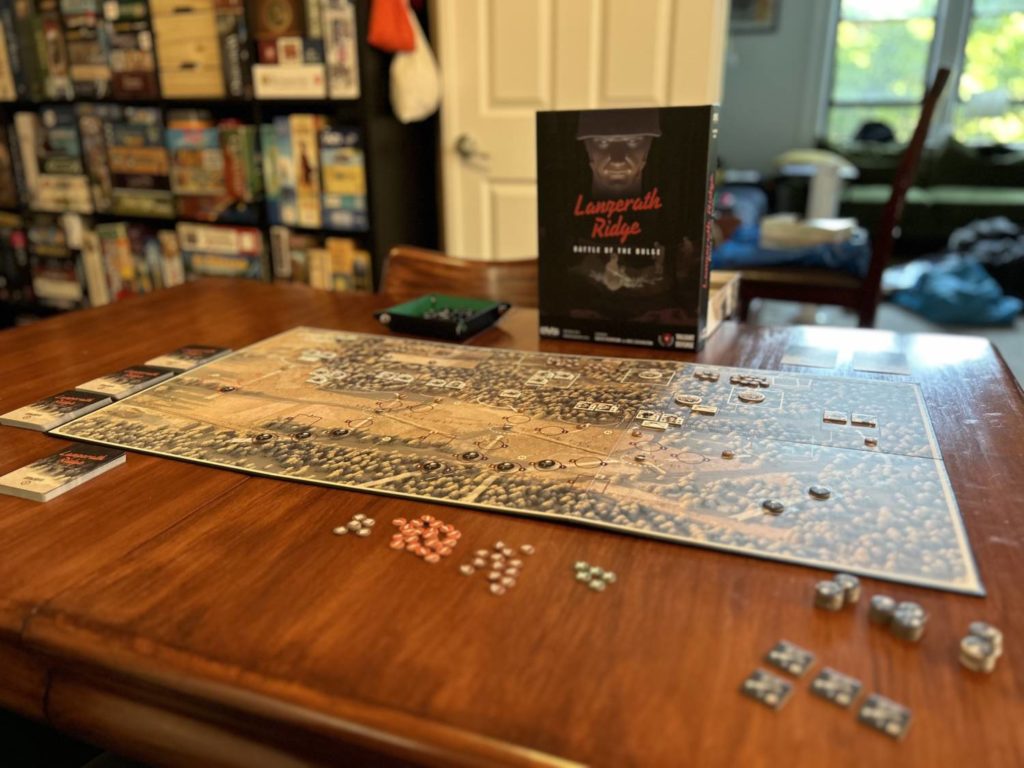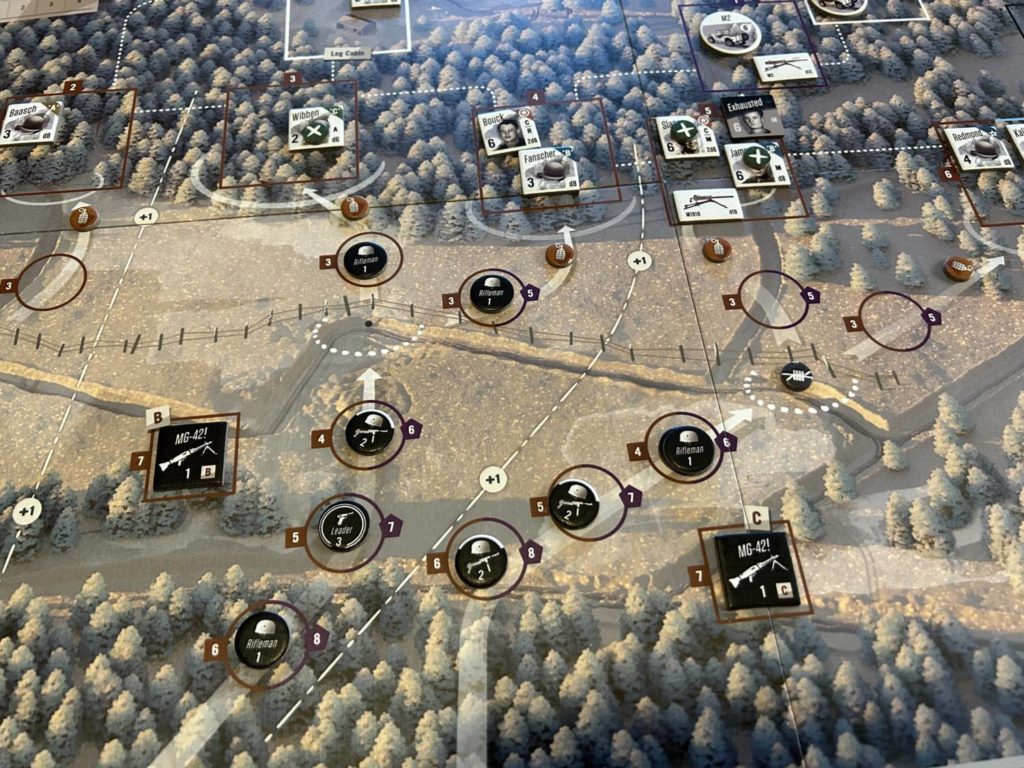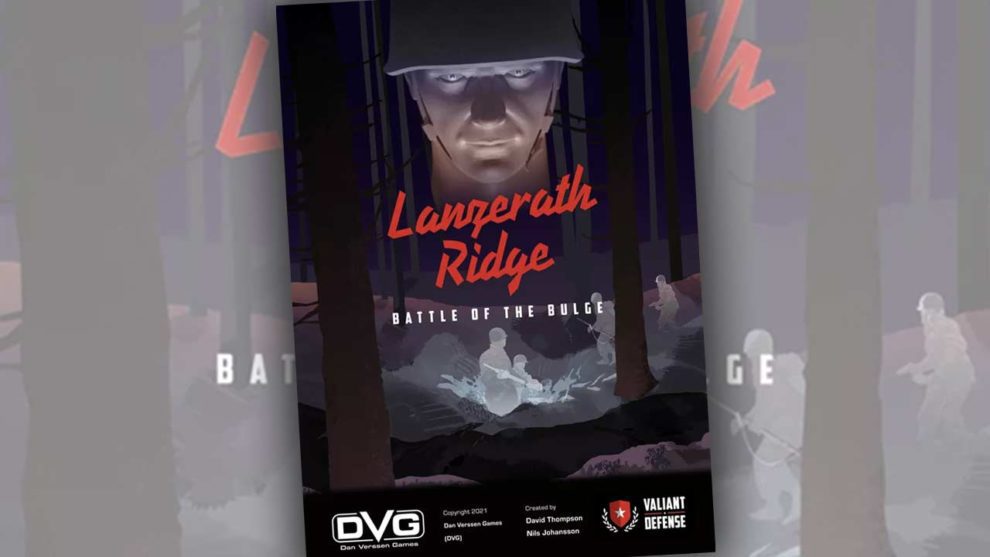Disclosure: Meeple Mountain received a free copy of this product in exchange for an honest, unbiased review. This review is not intended to be an endorsement.
I wasn’t particularly in the mood for Lanzerath Ridge, to be honest. That’s not to say I wasn’t looking forward to playing the fourth volume in designer David Thompson and publisher Dan Verssen Game’s Valiant Defense series. The second volume, Castle Itter, was at the center of one of my absolute favorite board gaming experiences. It’s just that I have a complicated relationship with solo gaming. The mood strikes occasionally, but the mood has to strike. I don’t casually sit down for a solo game in the same way I would for just about any multiplayer experience.
There are a couple of reasons for this. With smaller solo games, like Warp’s Edge or Under Falling Skies, the experience is apt to become a frantic one. The repetition of the turn cycle gets me keyed up. I rarely leave the table feeling relaxed or fulfilled, even if I won. I still want to play them, because I enjoy exploring the systems, but I’m not positive it’s good for me.
Larger solo games don’t have that problem. They exist in a space that I find incredibly relaxing. I’ve set up a game of Comanchería each of the last two Christmas breaks. I bathe in its relaxed rhythms, the complexity and richness of the choices it offers, and the strength of the storytelling. I have a copy of the new edition of Nemo’s War sitting on the shelf, and I’ll get there. I’m looking forward to it, even.
The problem larger solo games do have is time. They take up an awful lot of time that could be spent reading, writing, or practicing guitar. I can justify the hours I spend on multiplayer games every week by the fact that those games are intensely social, and friends are the most important part of life. Solo games, for me, are an indulgence. I’m a little too Protestant for that kind of thing.
So anyway, I wasn’t in the mood, but deadlines are what they are. I pulled the Lanzerath Ridge box off the shelf, laid out the board, organized the tokens, and reviewed the manual. I dealt the first three German Attack cards off the deck, administered their consequences, and got to the business of deciding what to do with my five actions. Within a minute, I was entirely absorbed.

I’m a Sucker for Numbered Spines
The Valiant Defense series, featuring games themed around particularly remarkable sieges from World War II, consists entirely of tower defense designs. In each, you play as soldiers trying to hold the line against significantly larger enemy forces. Pavlov’s House is about Russian soldiers in Stalingrad. Castle Itter concerns an unlikely allegiance of German, French, and American troops. Soldiers in Postmen’s Uniforms is about Polish postal workers holding a Post Office on the first day of the war. The (relative) obscurity of these settings is a big part of the appeal.
Lanzerath Ridge seems, at first blush, to be drawing from more obvious waters: the Battle of the Bulge. The historical notes in the manual address that concern almost immediately. Lanzerath Ridge is about a small group of American soldiers, 22 to be exact, who held back 550 German troops for most of a day before being captured. Their efforts delayed the advance of the 1st SS Panzer Division.
Forgive my lack of nuance on this matter, but I feel it is always good to delay the advance of the 1st SS Panzer Division.

The Line Must Hold
Over the course of four Attack Periods, representing each of the four waves of German advancement that took place on December 16th, 1944, you spend five actions per turn to move troops between various positions, send intelligence via radio back to headquarters, and fire on the German troops. If you survive all four Attack Periods without the Germans successfully breaching your position, and without completely losing morale, you win.
Moving your own soldiers around is mostly a matter of trying to put out fires, at least once the fight gets going. The art of playing Lanzerath Ridge well is in learning how best to be ahead of the fires. You cannot move a troop and attack with them on the same turn, and, in fact, if you are squeezed for manpower and have to move a unit from too far away, that man may not be able to help you until the next Attack Period.
Enemy actions come out three cards at a time. In some combination, troops advance, MG-42s fire, mortars hit. None of it is pretty. It is worth mentioning that dice play a significant role in Lanzerath Ridge, as they do throughout the Valiant titles. Dice determine where enemies deploy, where they fire, and the efficacy of your own attacks. The odds of any given event are pretty transparent, and paying attention to your troop placement gives you plenty of opportunity to increase your chances of success. Still, these are not games for the purely deterministic crowd.

Due for Promotion
Lanzerath Ridge features significantly improved production over the previous games in the series. The board is much more attractive to look at. The art on the cards is, well, art, rather than photographs with some Photoshop filters laid over the top. The graphic design on evidence here is high quality, compared to the more DIY aesthetic of the previous titles. David Thompson’s profile as a designer has increased significantly in the last two years, and I imagine that’s related to these changes. I hope DVG continues on this course. These games are much more approachable, much more fun, than their previous aesthetic indicated. I would happily pick up copies of the original three titles with this level of production.
That said, I would love a return to the older, larger token sizes. Previous installments of the series featured nickel- or even quarter-sized markers, and here they are about the size of a pea. I have large fingers, Mr. Verssen. Take pity on me, please.
As far as the design itself, I love the ways in which Thompson has adjusted the shared Valiant system to reflect the historical reality of Lanzerath Ridge. Instead of Castle Itter’s unforgiving, continuous grind of an attack, you have waves. Between Attack Periods, you have a chance to move your troops around, to reset to some extent. The reset makes this feel somewhat more forgiving than the previous installments, and I don’t have any issue with that.
You’ll sweat, you’ll swear quietly, you’ll have moments of tremendous success and horrible luck. You’ll marvel at your own wisdom and damn your own stupidity, often on the same turn. The game will end, either in triumph or tragedy. If you’re anything like me, you’ll find yourself thinking, as you pack it away, “Maybe I can play again tomorrow.”












Add Comment